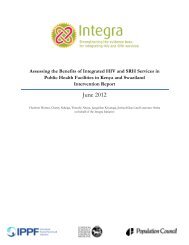ujh78
ujh78
ujh78
Create successful ePaper yourself
Turn your PDF publications into a flip-book with our unique Google optimized e-Paper software.
was more than four percentage points in Cameroon (2004: 17% and 2011: 22%) and Ghana (2003: 16 %<br />
and 2008: 21%) (see Figures 3.11 and 3.12).<br />
3.3 Medical Treatment of Diarrhea<br />
Seeking medical care for a child’s diarrhea is important because some treatments, such as<br />
antimicrobial chemotherapy, can shorten both bacterial excretion and the duration of the illness<br />
(Mandomando et al., 2007). Oral rehydration salt (ORS) and zinc tablets, when administered<br />
appropriately, are useful, cost-effective primary interventions for reducing diarrhea morbidity (Aggarwal<br />
et al., 2007; Bhatnagar et al., 2004; Fontaine, 2006; Gregorio et al., 2007). Unfortunately, however, many<br />
children do not obtain these medical treatments, even in areas where these services are available (Fischer<br />
Walker et al., 2009). In some instances people living in economically deprived neighborhoods are less<br />
likely than others to seek medical care (Aremu et al., 2011). A study by Aremu et al. (2011) that used<br />
DHS data from 11 countries in sub-Saharan Africa suggested that highly educated caregivers are more<br />
likely to utilize medical centers to manage childhood diarrhea. A major concern related to the treatment of<br />
diarrhea is that diarrheal pathogens are becoming resistant to antimicrobial agents; and some of the<br />
treatments for diarrhea, such as oral rehydration solutions, may not decrease the quantity of stool or the<br />
length of the disease. To address these issues, clinicians are employing combination therapies for<br />
managing diarrheal diseases, but that translates into an increased pill burden and longer therapy (Bardhan,<br />
2007; Njume and Goduka, 2012).<br />
As Map 3.3 shows, in 21 of 23 countries, at least 4 of every 10 children who had diarrhea in the<br />
two weeks prior to the survey did not receive medical advice. Benin (79%), Cameroon (76%), Mali<br />
(82%), and Niger (83%) had the highest percentages of children whose parents who did not seek medical<br />
advice (see Table 3.4). Malawi (38%) had the lowest percentage.<br />
Sex and geographic disparities<br />
In 17 of 23 countries, the percentage of children who did not receive medical advice was higher<br />
for girls than for boys (see Figure 3.13). This difference was greatest—at least 6 percentage points—in<br />
Rwanda (females: 66% and males: 60%), Lesotho (females: 50% and males: 43%), and Mali (females:<br />
86% and males: 79%) (see Table 3.4).<br />
Two-thirds of the sub-Saharan African countries experienced rural−urban disparities in the use of<br />
medical treatment for diarrhea (see Figure 3.14). Geographic disparities in lack of receiving medical<br />
advice for diarrhea were greatest—at least 15 percentage points—in Niger (urban: 70% and rural: 85%),<br />
Mali (urban: 70% and rural: 85%), Madagascar (urban: 50% and rural: 68%), Guinea (urban: 57% and<br />
rural: 78%), and Ethiopia (urban: 47% and rural: 70%) (see Table 3.4).<br />
The role of the household head’s sex and age<br />
In two-thirds of these sub-Saharan African countries, the percentage of children who did not<br />
receive medical advice for diarrhea was higher for children living with a male head of household than for<br />
children living with a female head of household (see Figure 3.15). This difference was greatest—more<br />
than 6 percentage points—in Mozambique (46% versus 40%), Guinea (74% versus 67%), Cameroon<br />
(77% versus 70%), and Nigeria (58% versus 47%) (see Table 3.4). The situation was reversed in Ghana<br />
(56% versus 62%) and Rwanda (61% versus 69%), where the percentage of children who did not receive<br />
medical advice was at least 6 percentage points higher for children living with a female head of household<br />
than for children living with a male head of household.<br />
In half of these sub-Saharan African countries, the percentage of children who did not receive<br />
medical advice for diarrhea was higher for children living with a household head younger than age 50<br />
36








